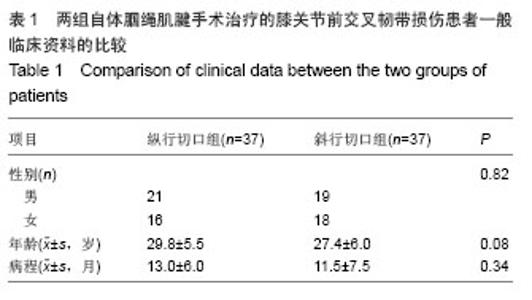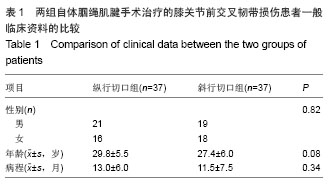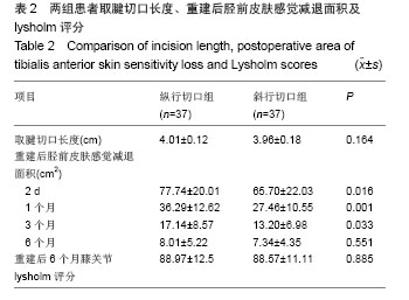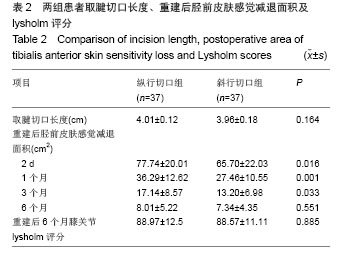| [1]Azar FM, Arthur ST. Complications of anterior cruciate ligament recon-struction. Tech Knee Surg. 2004;3:238-250.
[2]Salzler MJ, Lin A, Miller CD, et al. Complications after arthroscopic knee surgery. Am J Sports Med. 2014;42(2): 292-296.
[3]St. Pierre P. Complications of anterior cruciate ligament surgery. Sports Med Arthrosc Rev. 2004;12:185-195.
[4]Hagino T, Ochiai S, Watanabe Y, et al. Complications after arthroscopic knee surgery. Arch Orthop Trauma Surg. 2014; 134(11):1561-1564.
[5]Kang H, Cao J, Yu D. Deep vein thrombosis after arthroscopic anterior cruciate ligament reconstruction in a patient with primary thrombocytopenia. Acta Orthop Traumatol Turc. 2014; 48(4):455-458.
[6]Kim SJ, Postigo R, Koo S, et al. Infection after arthroscopic anterior cruciate ligament reconstruction. Orthopedics. 2014; 37(7):477-484.
[7]Crawford DC, Hallvik SE, Petering RC, et al. Post-operative complications following primary ACL reconstruction using allogenic and autogenic soft tissue grafts: increased relative morbidity risk is associated with increased graft diameter. Knee. 2013;20(6):520-525.
[8]Shelbourne KD, Gray T. Minimum 10-year results after anterior cruciate ligament reconstruction: how the loss of normal knee motion compounds other factors related to the development of osteoarthritis after surgery. Am J Sports Med. 2009;37(3):471-480.
[9]Rue JP, Lewis PB, Parameswaran AD, et al. Single-bundle anterior cruciate ligament reconstruction: technique overview and comprehensive review of results. J Bone Joint Surg Am. 2008;90 Suppl 4:67-74.
[10]Järvelä T, Moisala AS, Sihvonen R, et al. Double-bundle anterior cruciate ligament reconstruction using hamstring autografts and bioabsorbable interference screw fixation: prospective, randomized, clinical study with 2-year results. Am J Sports Med. 2008;36(2):290-297.
[11]Inderhaug E, Strand T, Solheim E. The impact of sensory deficits after harvesting hamstrings autograft for ACL reconstruction. Knee Surg Sports Traumatol Arthrosc. 2014. in press.
[12]Nelissen E, van Arkel ER, Hazelbag HM. Traumatic neuroma of the infrapatellar branch of the saphenous nerve after hamstring harvesting. J Knee Surg. 2010;23(4):233-236.
[13]Xu Y, Ao YF, Yu JK, et al. Compare the clinical results of double-bundle with single-bundle anterior cruciate ligament reconstruction. Zhonghua Wai Ke Za Zhi. 2008;46(4): 274-276.
[14]Sgaglione NA, Warren RF, Wickiewicz TL, et al. Primary repair with semitendinosus tendon augmentation of acute anterior cruciate ligament injuries. Am J Sports Med. 1990; 18(1):64-73.
[15]Aglietti P, Giron F, Buzzi R, et al. Anterior cruciate ligament reconstruction: bone-patellar tendon-bone compared with double semitendinosus and gracilis tendon grafts. A prospective, randomized clinical trial. J Bone Joint Surg Am. 2004;86-A(10):2143-2155.
[16]Figueroa D, Calvo R, Vaisman A, et al. Injury to the infrapatellar branch of the saphenous nerve in ACL reconstruction with the hamstrings technique: clinical and electrophysiological study. Knee. 2008;15(5):360-363.
[17]郝艳丽,周正宏,刘艳华,等.前交叉韧带重建胫骨切口位置与胫前皮肤感觉障碍临床研究[J].中国运动医学杂志,2010,29(1): 59-61,64.
[18]Sabat D, Kumar V. Nerve injury during hamstring graft harvest: a prospective comparative study of three different incisions. Knee Surg Sports Traumatol Arthrosc. 2013;21(9):2089-2095.
[19]Jameson S, Emmerson K. Altered sensation over the lower leg following hamstring graft anterior cruciate ligament reconstruction with transverse femoral fixation. Knee. 2007; 14(4):314-320.
[20]Tegner Y, Lysholm J. Rating systems in the evaluation of knee ligament injuries. Clin Orthop Relat Res. 1985;(198):43-49.
[21]Bertram C, Porsch M, Hackenbroch MH, et al. Saphenous neuralgia after arthroscopically assisted anterior cruciate ligament reconstruction with a semitendinosus and gracilis tendon graft. Arthroscopy. 2000;16(7):763-766.
[22]Kalthur SG, Sumalatha S, Nair N, et al. Anatomic study of infrapatellar branch of saphenous nerve in male cadavers. Ir J Med Sci. 2014. in press.
[23]Kerver AL, Leliveld MS, den Hartog D, et al. The surgical anatomy of the infrapatellar branch of the saphenous nerve in relation to incisions for anteromedial knee surgery. J Bone Joint Surg Am. 2013;95(23):2119-2125.
[24]Dunaway DJ, Steensen RN, Wiand W, et al. The sartorial branch of the saphenous nerve: its anatomy at the joint line of the knee. Arthroscopy. 2005;21(5):547-551.
[25]Dayan V, Cura L, Cubas S, et al. Surgical anatomy of the saphenous nerve. Ann Thorac Surg. 2008;85(3):896-900.
[26]Sanders B, Rolf R, McClelland W, et al. Prevalence of saphenous nerve injury after autogenous hamstring harvest: an anatomic and clinical study of sartorial branch injury. Arthroscopy. 2007;23(9):956-963.
[27]Daikuya S, Suzuki T, Yabe K. Neuromuscular function after reconstruction of anterior cruciate ligament--a case study using evoked electromyography. Electromyogr Clin Neurophysiol. 2008;48(3-4):131-137.
[28]Oztekin HH, Boya H, Ozcan O, et al. Pain and affective distress before and after ACL surgery: a comparison of amateur and professional male soccer players in the early postoperative period. Knee. 2008;15(5):368-372.
[29]Haber M, Kovan E, Andary M, et al. Postinjection vastus lateralis atrophy: 2 case reports. Arch Phys Med Rehabil. 2000;81(9):1229-1233.
[30]罗浩,敖英芳,彭立彬,等.膝关节前交叉韧带重建术取腱切口方向与隐神经髌下支损伤关系探讨[J].中国运动医学杂志,2006, 25(3):294-296.
[31]Boon JM, Van Wyk MJ, Jordaan D. A safe area and angle for harvesting autogenous tendons for anterior cruciate ligament reconstruction. Surg Radiol Anat. 2004;26(3):167-171.
[32]Eriksson K, Hamberg P, Jansson E, et al. Semitendinosus muscle in anterior cruciate ligament surgery: Morphology and function. Arthroscopy. 2001;17(8):808-817. |



